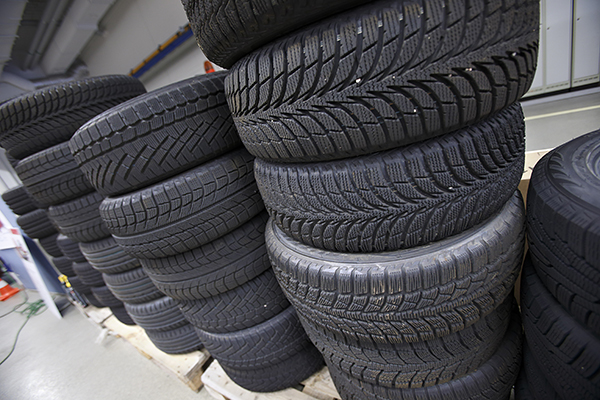When it comes to maintaining your vehicle, one of the most critical decisions you’ll make is choosing the right type of tyres. While all tyres serve the same purpose of providing grip, stability, and safety, the specific types—winter tyres and summer tyres—are designed for different driving conditions. Understanding the differences between these tyre types can significantly improve your safety and vehicle performance, especially when faced with extreme weather conditions.
In this article, we will dive into the differences between winter and summer tyres, and help you understand when and why each type is necessary for optimal driving performance.
What Are Winter Tyres?
Winter tyres, also known as snow tyres, are specially designed to provide superior performance in cold, snowy, and icy conditions. They are made with a unique rubber compound that remains flexible even in freezing temperatures, which is essential for maintaining traction on slippery surfaces.
Key Features of Winter Tyres:
- Softer Rubber Compounds: Winter tyres use a softer rubber compound that stays flexible in cold temperatures. This allows the tyre to grip the road better, even in freezing conditions, providing superior control.
- Deep Treads with Wide Grooves: The tread pattern on winter tyres is designed to channel snow, slush, and water away from the contact patch, improving traction and reducing the risk of hydroplaning.
- Increased Biting Edges: Winter tyres have many small, jagged edges that “bite” into the snow and ice, improving grip and braking power in winter conditions.
- Snowflake Symbol: Winter tyres are often marked with a snowflake symbol to indicate they meet specific performance standards for winter driving.
Best Conditions for Winter Tyres:
- Cold Weather: Winter tyres excel in temperatures below 7°C (45°F), even if there is no snow on the ground. The rubber compound remains more pliable, allowing better road contact.
- Snow and Ice: These tyres are specifically designed to perform well on snowy, icy, or slushy roads, where regular tyres may struggle to maintain control.
- Wet Conditions: Winter tyres are also effective in wet conditions, as their tread design helps with water evacuation, reducing the risk of aquaplaning.
Why Winter Tyres Are Important:
Winter tyres are essential in ensuring maximum safety during colder months. Without them, your vehicle’s stopping distance increases significantly in icy or snowy conditions, and your car becomes more difficult to control. These tyres offer better performance in both acceleration and braking, which is crucial when driving in winter conditions.
What Are Summer Tyres?
Summer tyres are designed to perform optimally in warm and dry conditions. They are built with a harder rubber compound that provides enhanced performance on dry and wet roads during the warmer months. Summer tyres are the preferred option for vehicles that don’t face extreme cold or snow.
Key Features of Summer Tyres:
- Harder Rubber Compounds: The rubber used in summer tyres is stiffer compared to winter tyres, which allows them to handle higher temperatures without becoming too soft or wearing out prematurely.
- Shallow Treads: Summer tyres typically have shallower tread depths with fewer grooves, which helps maximize the contact area between the tyre and the road, leading to better handling, cornering, and stability.
- Optimized for Dry Roads: The tread pattern of summer tyres is designed to perform best on dry surfaces, providing excellent grip and traction for responsive steering and fast cornering.
- Better Performance in Wet Conditions: Although they are not as effective as winter tyres on snow and ice, summer tyres perform better than all-season tyres on wet roads due to their superior handling and water dispersion abilities.
Best Conditions for Summer Tyres:
- Warm Weather: Summer tyres are ideal for temperatures above 7°C (45°F). They offer excellent performance on both dry and wet roads during the warmer months.
- Dry and Wet Roads: These tyres offer enhanced handling, braking, and fuel efficiency on dry roads. They also perform reasonably well in wet conditions, providing a better grip than all-season tyres.
- High-Speed Driving: Summer tyres are designed for high performance, so they provide excellent stability at high speeds, making them suitable for sports cars and performance vehicles.
Why Summer Tyres Are Important:
Summer tyres are engineered to offer superior grip, handling, and performance in warm conditions. They deliver responsive steering and smooth cornering, which is particularly important for those who prioritize driving performance. Using summer tyres in warm weather helps improve safety, reduce wear and tear, and increase fuel efficiency.
Key Differences Between Winter and Summer Tyres
Now that we have discussed the individual characteristics of winter and summer tyres, let’s compare them head-to-head to highlight the key differences.
1. Rubber Composition
- Winter Tyres: Made with a rubber compound designed to remain flexible in cold temperatures. This flexibility allows better traction on cold, icy, or snowy surfaces.
- Summer Tyres: Made with a harder rubber compound, ideal for warmer temperatures. The harder rubber provides better grip on dry and wet roads during the summer months.
2. Tread Pattern
- Winter Tyres: Deep, aggressive tread patterns with wide grooves and numerous biting edges designed to handle snow, ice, and slush.
- Summer Tyres: Shallow treads with fewer grooves. The tread design prioritizes road contact for enhanced performance on dry and wet roads.
3. Performance in Cold Weather
- Winter Tyres: Perform significantly better in temperatures below 7°C (45°F) and excel in snow and ice.
- Summer Tyres: Not designed for cold weather. In freezing conditions, the rubber hardens, reducing traction and handling ability.
4. Performance in Wet Conditions
- Winter Tyres: Effective at reducing the risk of hydroplaning due to their specialized tread pattern designed for water evacuation, although their primary focus is on snow and ice.
- Summer Tyres: Perform well on wet roads, with excellent water dispersion, but are not suited for freezing rain or snowy conditions.
5. Durability and Wear
- Winter Tyres: Tend to wear faster when used in warm weather because the rubber compound is softer. It is essential to switch to summer tyres when temperatures rise to avoid unnecessary wear.
- Summer Tyres: Are built to last longer in warm weather and maintain their performance for longer periods.
When to Use Winter and Summer Tyres
Knowing when to switch between winter and summer tyres is crucial for maintaining performance and safety.
- Winter Tyres: Install winter tyres when temperatures consistently drop below 7°C (45°F) and when there is the possibility of snow or ice. It’s a good idea to make the switch before the first frost of the season and replace them with summer tyres once the weather warms up.
- Summer Tyres: Install summer tyres when the weather remains consistently warm and dry. They should be used during the summer months, as well as in spring and autumn when temperatures are above 7°C (45°F).
Hybrid Option: All-Season Tyres
If you live in a region with mild winters and don’t experience extreme weather conditions, you might consider all-season tyres. These tyres are a compromise between winter and summer tyres and can handle moderate weather changes, but they are not as effective as dedicated winter or summer tyres in their respective conditions.
Choosing between winter and summer tyres depends on the climate in which you live and the type of driving you do. Winter tyres provide essential safety and performance in cold, snowy, or icy conditions, while summer tyres deliver superior handling and braking in warm weather. Understanding the differences between the two will help you make an informed decision that maximizes your vehicle’s performance and safety. If you’re looking for expert guidance and high-quality tyre options, Tire Pte Ltd offers a wide selection to suit different driving needs. Whether you live in a region with harsh winters or warm climates, using the correct tyre for the season is one of the best investments you can make for your vehicle.











